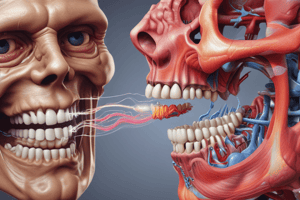Podcast
Questions and Answers
What is dehiscence?
What is dehiscence?
When an incision fails to heal properly, the layers of skin and tissue separate. This most commonly occurs before collagen formation (3 to 11 days after injury).
Who is at risk for dehiscence?
Who is at risk for dehiscence?
Patients with poor wound healing conditions such as poor nutritional status or infection are at risk. Obese patients have a higher risk due to constant strain on their wounds.
What might cause dehiscence? What might prevent it?
What might cause dehiscence? What might prevent it?
Dehiscence can happen in abdominal surgical wounds after sudden strain such as coughing or sitting up in bed. Preventative measures include abdominal binding and splinting.
What are some indicators that dehiscence has occurred?
What are some indicators that dehiscence has occurred?
What is evisceration?
What is evisceration?
What is an evisceration considered? What should you do as the RN?
What is an evisceration considered? What should you do as the RN?
What is the implication of organs protruding through the wound?
What is the implication of organs protruding through the wound?
Flashcards are hidden until you start studying
Study Notes
Dehiscence
- Definition: Failure of an incision to heal properly, leading to partial or total separation of wound layers.
- Timing: Most commonly occurs 3 to 11 days post-injury, before collagen formation.
- Commonly seen in abdominal surgical wounds.
Risk Factors for Dehiscence
- Poor wound healing due to factors such as inadequate nutrition and infection.
- Obesity increases risk due to constant strain on wounds and poor healing characteristics of fat tissue.
Causes and Prevention of Dehiscence
- Sudden strain events (e.g., coughing, vomiting, rising from bed) can lead to dehiscence.
- Prevention strategies include abdominal binding and splinting the wound area.
Indicators of Dehiscence
- Patient reports a sensation of something giving way in the wound area.
- Increased serosanguineous drainage from the wound within the initial days post-surgery suggests potential dehiscence.
Evisceration
- Definition: A more severe condition where there is total separation of wound layers, leading to protrusion of visceral organs through the wound.
- Considered a surgical emergency with immediate intervention required.
Actions in Case of Evisceration
- Cover the protruding organs with sterile gauze soaked in saline to prevent infection and drying.
- Contact the surgical team immediately.
- Keep the patient NPO (nothing by mouth) to prepare for potential emergency surgery.
- Monitor for signs and symptoms of shock in the patient.
Implications of Protruding Organs
- Protrusion can compromise blood supply to the affected tissues, posing serious health risks.
Studying That Suits You
Use AI to generate personalized quizzes and flashcards to suit your learning preferences.




